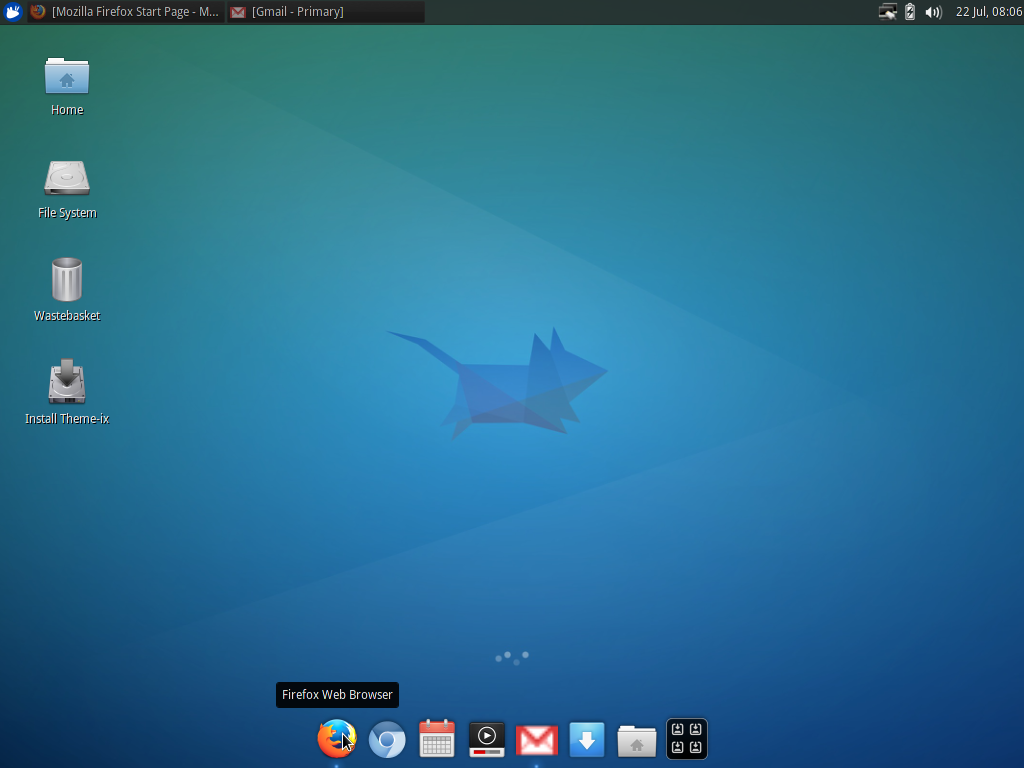Current stable version: 0.3.0
Current development version: 0.6.1
Released: 2014-06-17
Background
Plank is a minimalist panel with aims to stay minimal (see website). It is actually the foundation for Docky and shares the same website, but can and is used as a standalone dock. It is in active development and uses bamf for window identification.
Installing
Plank does not exist in the Debian repositories and installing it took a bit of research and trial and error. This is because not all the required dependencies can be installed on Debian, because some aren’t available and others have a naming mismatch with Ubuntu debs. I decided to install the current development version which according to the website is meant to be pretty stable. Here is what I had to do:
1. Install from Jessie:
- valac-0.16
- libbamf3-0
- libdebusmenu-gtk3-4
- libgee-0.8-2
- libc6
- http://packages.ubuntu.com/saucy/libbamf3-2
- Install using gdebi or - dpkg -i
- deb http://ppa.launchpad.net/ricotz/docky/ubuntu trusty main
- Add the public siging key: 9E5DB0C8
- Install plank using apt or Synaptic
Running Plank
Plank shows up under the Accessories menu. At first, I thought it hadn’t run or installed correctly, but the default behaviour is intelli-hide. Run your mouse to the bottom of the screen and you’ll see it appear or it will appear if all windows are minimised:

Plank shares the same anchor icon as Docky, but whereas the Docky icon brings up a preferences windows, the Plank icon merely shows the version number. It’s not useful but can be removed by deleting the plank.dockitem file in the config directory. The second icon is actually the launcher for Firefox. It works, but the icon is missing because I installed Firefox manually in Debian. All I had to do was drag the icon off the dock to remove it, then launch Firefox using the XFCE Whisker menu and pin it by right-clicking the icon. By default I also randomly got an Orage and Parole launcher on the dock.
Customization
The principle of Plank is to be simple - always. “Plank is meant to be the simplest dock on the planet. The goal is to provide just what a dock needs and absolutely nothing more.” With that in mind, you might not expect much in the way of customization. Well surprisingly there are quite a few themes available for Plank and there are some customization options, but there are no GUIs. You will need to edit config files and delve into your OSs file system (but it’s not that hard!)
First you need to get some themes. There are a couple of sites that I have found:
1. Cassidy James on DeviantArt
2. ElementaryOS Update ppa
3. Plank-Themer by Rho Con Linux
Essentially, themes are either downloaded into the global /usr/share/plank/themes directory, or the local ~/.local/share/plank/themes.
Customization of the dock itself is controlled by the config file at ~/.config/plank/dock1/settings and is limited to icon size, hide mode, dock position, alignment, monitor mode, theme and offset from the center. Most settings are defined by a number from 0-3 and are described within the auto-generated file itself.
ElementaryOS features a GUI to alter these settings and the Plank-Themer linked above provides a dock item to quickly change theme.
Features/Applets
There are no additional features or applets for Plank. There is no system tray or notification area and no applications menu. If you want these things, you are directed to Docky.
Stability/Resource Use
Plank was very stable in my tests. The simplicity of it means that it appears almost instantly and uses very few system resources - a few MB at most that I could tell.
Overall impressions
It may not be the easiest Dock to either install on Debian or to configure. Themes are dotted about throughout the Internet, but they are attractive and probably provide most of the appearances that most people would desire. The plus side for Plank is that it is lean and stable. As long as you only need a dock and nothing else, it compares very favourably with the other docks on test.
Category
|
Score /10 |
|---|---|
| Ease of installation | 4 |
| Customization | 7 |
| Features | 3 |
| Stability | 9 |
| Overall | 8 |
Here is a screenshot with the fully transparent theme that ships with Plank-Themer:

Copyright (c) RichJack 2014
Written with StackEdit.
This work is licensed under a Creative Commons Attribution-ShareAlike 4.0 International License.

It would have been helpful if the installation was more detailed.
ReplyDeleteEven after installing all those dependencies, "apt-get" still says -
Reading package lists... Done
Building dependency tree
Reading state information... Done
E: Unable to locate package plank
Thanks
PS- Point Linux(release 2.3.1, taya) with MATE 1.4.2
Try apt-get update first after adding the ppa, then you should be able to install it.
DeleteTry apt-get update first after adding the ppa, then you should be able to install it.
DeleteNothing works
DeleteThis comment has been removed by the author.
ReplyDeleteI think plank is now on the Debian experimental repository, you might have better luck installing from there.
ReplyDelete*buntu 14.04 and newer:
ReplyDeletesudo add-apt-repository ppa:ricotz/docky -y && sudo apt update && sudo apt install plank -y
Control+Right Click the dock to access preferences.
Hi I use deb.8. It is something wrong bitween libglib 2 and 3.
ReplyDeleteIt seems impossible to install.
I install cardapio in mu xubuntu 16.10 and now I have an aplication menu in plank...the only thing left its a systray...but there is no standalone systray that works as an app...so no luck for me.
ReplyDelete